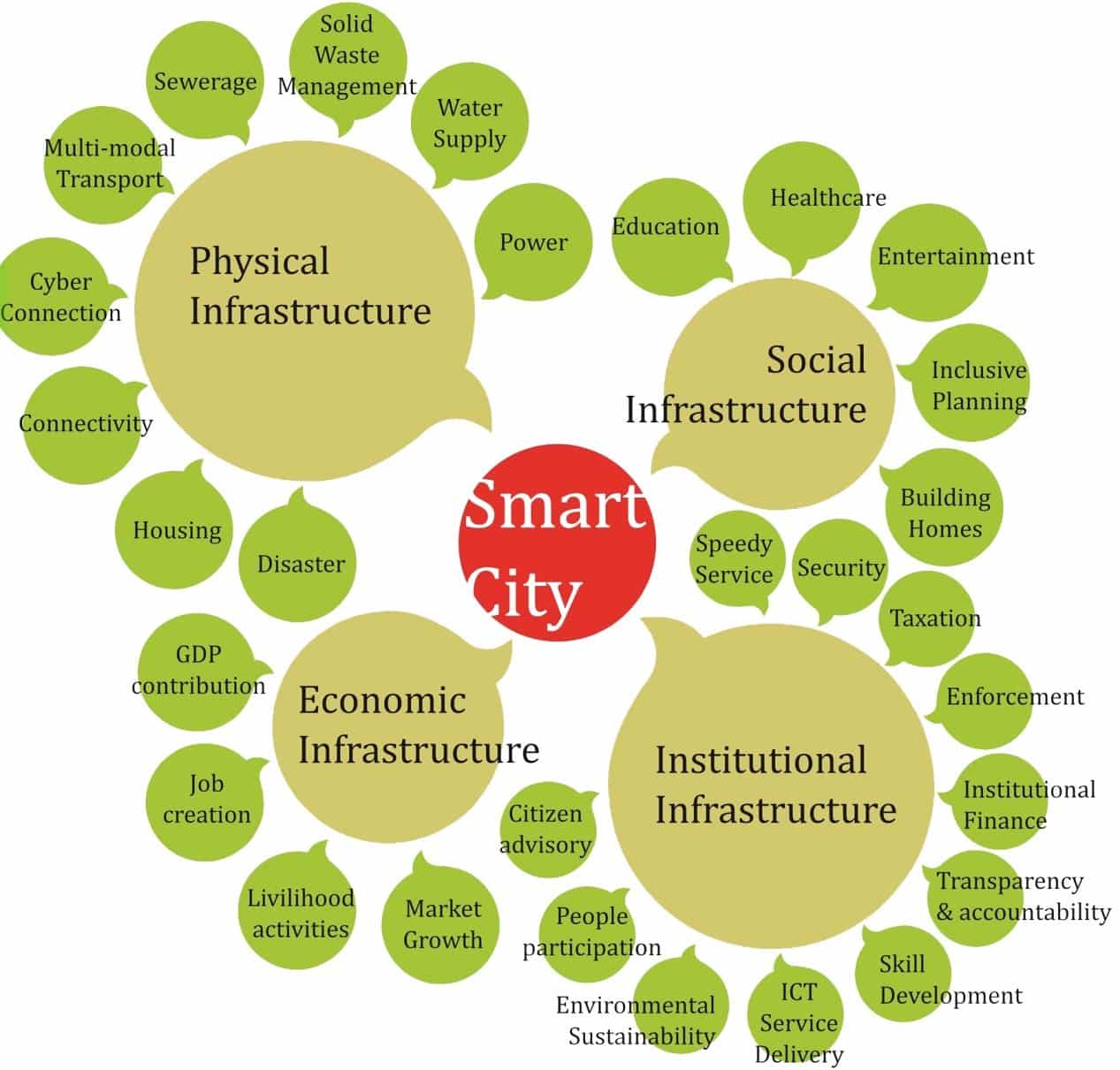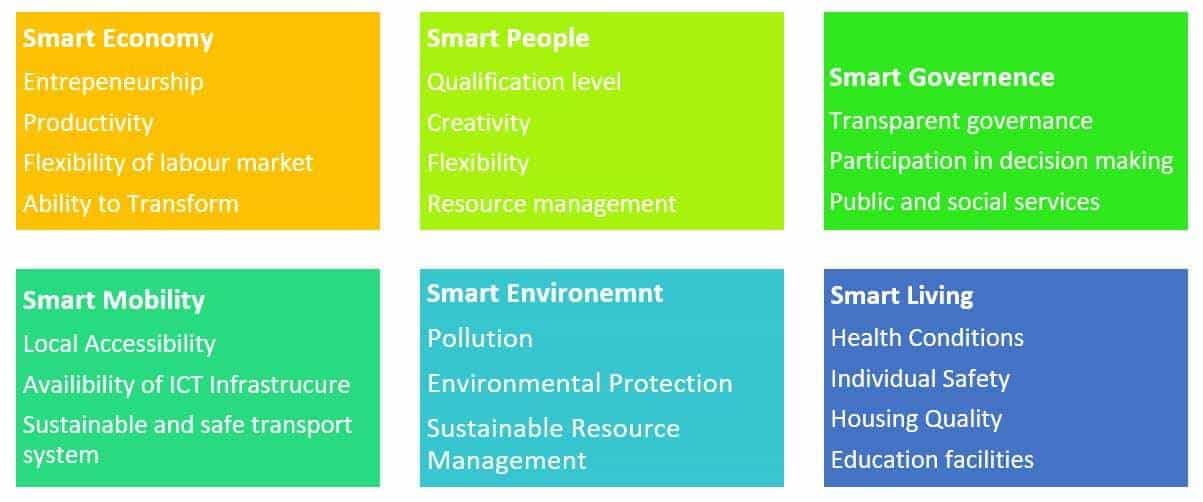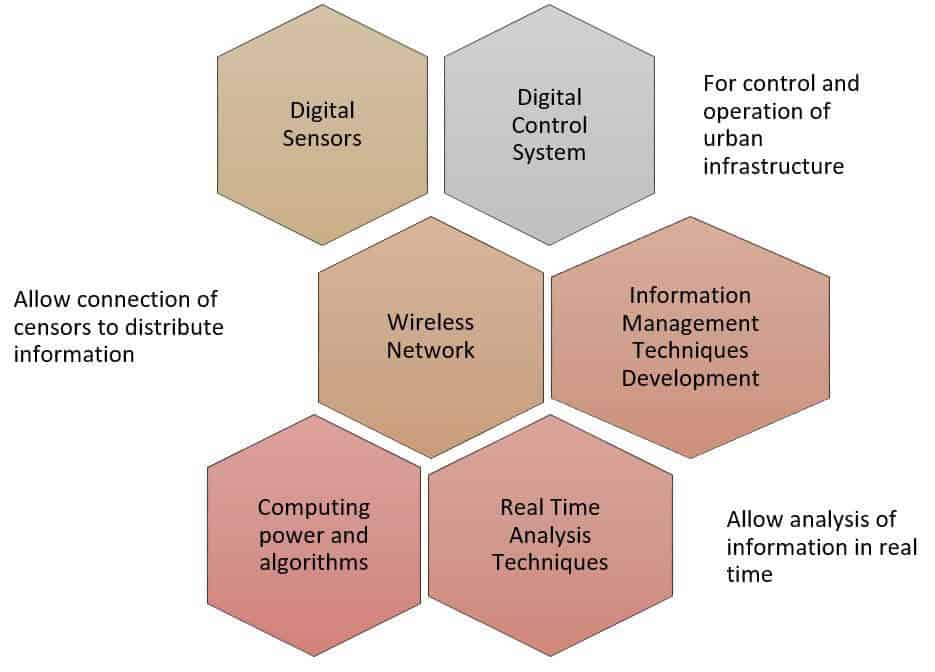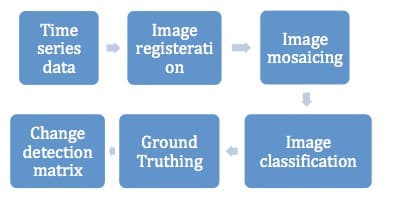Why make our traditional cities “Smart”
Cities are spatial, cultural, social , economic, political, legal, democratic and ecological system. Spatial System can be studied from land use and urban networks and services. Cities have abilities to uplift any nation, converting cities to smarter cities makes smarter nations by planning, management, governance and development systems. At present, planning system prepares master plans, zonal plans, urban land management schemes and site planning schemes to achieve the goals of the spatial system that needs a careful relook for the creation of smart cities. Management and governing systems now in operation are legacy colonial with inefficient hierarchical system that is least responsive and in real-time outmoded and cumbersome for the end users.
Smart city is the city of tomorrow, which tries to identify a smarter option from legacy system for maximizing the end-user satisfaction and accelerating urban socio-cultural and economic development. Smart city is knowledge based city functioning on most latest and updated information on automated decision-making and rapid action for individuals.

GIS is a technology to capture, store and manipulate, analyze and visualize spatially referenced data. It is used for spatial analysis and modeling. GIS allows viewing, interpreting and visualizing data in many ways that reveal relationships, patterns and trends in form of maps, reports and charts. It helps in delivering creation of multiple scenarios in time.It integrates hardware, software, data and people for capturing , managing , analyzing and displaying all forms of geographically referenced data.
Related: Who uses GIS Software
Geographic information systems are used for planning too but in most of the developing nations its application is limited to scale in urban management and governance. However, these have not resulted in drastic reduction in issues faced by urban residents. These have not helped in reducing long commutation distance, unnecessary bottlenecks and congestion, retarded unemployment generation during the time of economic down turns and pollution of air, water and land. There is a need to study these issues with all the complexity in order to modify a city to a smarter city that can overcome these emerging urban developments in a smarter way.
Geographic Information System for Smart Cities
GIS has got the capacity to model the real world of the city in totality. It can incorporate millions of variables and has the capacity to geocode these variables and stimulate for planning, management and development of a city. The hardware platform of computers is in the process of increasing its capacity for GIS computations almost everyday.
Smart city is knowledge based city that develops extra ordinary capabilities to be self-aware; functions 24 hours and 7 days a week; communicates, selectively, knowledge in real-time to citizen end users satisfactory way of life with easy public delivery of services, comfortable mobility, conservation of energy , environment and other natural resources and creates energy face to face communities and a vibrant urban economy even at a time of national economic downturns.

Smart city components increase the following:
- Economic competitiveness
- Social and human capital
- Participation
- Transport and ICT
- Natural resources
- Quality of life
Factors for identification of smart city which are as follows:
- Broadband connectivity
- Knowledge workforce
- Digital inclusion
- Innovation
- Marketing
- Advocacy
Traditionally used for mapping master plans, zonal plans and development schemes. Urbanization policy based on GIS can lead to broad allocation of land for future urbanization and demarcation of areas for future urbanization. GIS-mapping of non urban areas and eventual integration with urban areas can be achieved through national GIS.
Related: Remote Sensing – Types & How it Works
An intelligent GIS assist the user in analysis , requires following capabilities:
- Capability to understand user’s information seeking goal
- Capability to select and visualize appropriate data in an away productive for achieving these goals
- Capability to support the user’s analytical activity by using of the generated presentations.
Designing a smart city in an existing or new town or managing a smart city demand enormous spatially referenced database. GIS provides spatially referenced data base ( with latitude, longitude) and non-spatial data ( census, TVC, climate data, water supply statistics) and includes operation which supports spatial analysis in GIS. Attribute data in income can be utilized to study in GIS, mobility by income group on an average day and their preferred modes of transport based on distance covered. This can be converted to smart mobility in a smart city design.
Benefits of application of GIS in Smart Cities:
- Smart cities can create smart communities to analyze and find issues for local community.
- It produces citizens who are in continuing and lifelong education.
- Smart cities can identify appropriate representatives for multi level local governance as part of self organizing policy.
- Smart Cities can reduce resource consumption, energy and water , reduction in carbon emission
- Improve utilization of existing infrastructure capacity, improving quality of life
- Can provide real-time guidance on how best to exploit multiple transportation modalities, make new services available.
- GIS can help visualizing spatial impacts of situations and migratory patterns and help in planning for urbanization.
For creation of smart cities progress in the following is needed
The intent of smart cities is to make urbanization more inclusive, bringing together formal and informal sectors, connecting urban cores with peripheries, delivering services for the rich and poor alike, and integrating the migrants and poor into the city. GIS is being used in existing cities and adapting these to be smart as well as those cities that are being created from scratch. ICT is used as a means of achieving the smartness.

The planning for urban settlements has to graduate from a cosmetic “GIS Mapping” approach to a comprehensive geo spatial analysis and solution approach. Cities need a complete shift to the use of spatial technology, geographic information system (GIS) and related advancements as routine process. GIS and related technologies like GPS can be used for accurately mapping of existing settlement patterns at national, state and regional levels. GIS helps in delivery of creation of multiple scenarios in time which help in time-saving and efficient decision-making.
Related: Smart City Concept by MoUD, Govt. of India
Smart cities are being technology driven with key focus on sustainability, likewise , for smart urbanization GIS and related technologies should be used, which will be time-saving and enhance quality of decision-making. Existing urban and rural schemes should be used towards achieving this and should be further integrated within the National GIS PROGRAM of the government to achieve smart urbanization for sustainable living.
Satellite image application for sustainable living
Land use planning using GIS overlay on satellite images
Existing data base of existing land use plan in GIS facilitates site suitability analysis to arrive at a proposed land use that is efficient. Analysis is performed with help of GIS as a decision support system in monitoring changes in land use and its intensity over time in an urban area.
Detection and assessment of unauthorized settlements – Emerging slums can be detected and tackled early through regular support from satellite images to observe the extent of encroachment . Redevelopment measures can be facilitated through the digitization of base map and attachment of associated information collected through household survey on GIS platform.
Managing Urban Sprawl: Time series satellite images help in identification of underutilized lands within the city for redevelopment and provide information about land use conversions.. Helps in monitoring horizontal spread of urban areas. Compact cities can be developed by integrating use of time series satellite images in city planning.
Identification & prediction of growth direction: Time series data allows a comprehensive view of entire region and beyond, which can be used to stimulate and quantify impacts of specific policy inputs like IT Park, proposed transportation network etc.
Transportation Planning: Satellite images provide base map of existing transportation corridors in different modes and facilitate the alignment of additional linkages to accommodate future development.
Urban Environment: Helps to interpret characteristics and conditions of specific pollutants in air, water and land. This data can be used to assess the environmental impact of LULCC.
Change Detection in urban areas using GIS
Digital remote sensing data available through aerial photographs and satellite images are converted into useful information such as land cover maps.Overlay of collateral data like digital elevation models, soil and geology maps, block population statistics ,separately residing in GIS are of great value in analysis of remotely sensed data.
Time series satellite images are reliable source of spatial information. Relevant features are digitized in vector format . Image classification and interpretation using time series images forms the basis for image detection.Images are registered using toposheets, ground control points with help of global positioning system.Region of interest lies in more than one scene. Different scenes need to be mosaic-ed to obtain a seamless picture to obtain a uniform histogram of classification.

Raster data of ROI is classified into a fixed no. of classes. Classification results are validated by ground trothing. Classification results are exported to detect the changes like land use land cover change spread over significant length of time .By overlay of GIS vector format on satellite images in raster form, it provides the base map for quantification of environmental impacts that offset sustainability and facilitate the identification of the polluters and the beneficiaries, both by their attributes and their locations.
Related: Bhuvan by ISRO